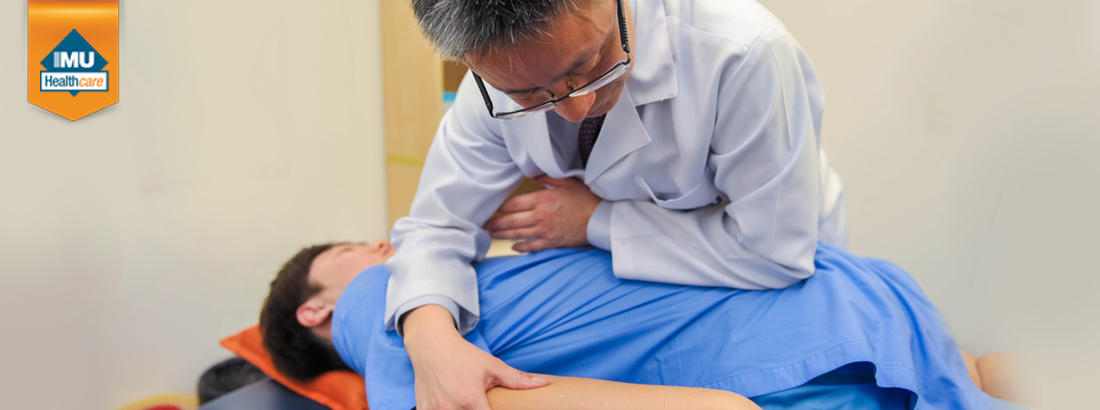Badminton? No sweat. Zumba? Sure, as human beings, most of us enjoy sweating it out. Naturally, the human body itself evolved as a result of favouring brains over brawn despite being optimised as one of nature’s most tactile creatures, it is nevertheless fragile. Professor Lin Xun, a senior Chinese medicine physician at IMU Healthcare Chinese Medicine Centre weighs in on how our bodies are able to do much more with sports-related treatment like Tui Na.
Tui Na, based upon 2,000-year-old ancient Chinese medical principles is an external therapeutic method in Traditional Chinese Medicine (TCM) that supplements a person’s sports performance as well as to aid in recovery. By manipulating ‘Qi’ (inner essence) in the human body and improving blood circulation, the method is able to facilitate rapid healing in more ways than one.
Benefits of Sports Tui Na Sports Tui Na is able, but is not limited to:
| Promote Qi and Blood Circulation |
| The manipulations of Tui Na can help increase blood flow to the muscles and improve the state and functions of a body’s organs such as the heart. |
| Improve Sports Performance |
| Sports Tui Na supplements the warm-up process by enhancing circulation and reducing excess muscle and mental tension prior to sports activities or competition. The range of motion and muscle flexibility are improved, if not reducing the chance of injury. |
| Enhance the Recovery of Injuries |
| Treatment speeds up blood and lymphatic circulation to reduce swelling, relax adherence, and improve movement of affected areas, so that the injured joints and tendons can return to natural movement. In many Western countries, massage is a vital component of sports as it involves the relaxation and relief of muscular stress and tension. Sports Tui Na, according to Professor Lin involves a complex manipulation system that seeks to improve a person’s overall health and well-being while acting as a primary method of treating sports related injuries in China. In China, sports Tui Na is a preferred method of therapy, with teams having their own dedicated sports Tui Na practitioners on standby. |
Type of Sports it is Suitable for Sports Tui Na is suitable for any activity involving intensive movement such as jumping or swimming. In badminton, jumping is a fundamental movement. Many other forms of sports involve a combination of jumps, stretches and sudden bursts of energy movements too, thus rendering the sport players more susceptible to injuries. How it works “Sports Tui Na is divided into two stages: before sports and after sports”, says Professor Lin.
Before sports |
Tui Na helps the body gain optimal performance by activating qi and blood circulation, thus loosening and warming up the muscles. It prepares the body for intensive movements and prevents acute injuries during such intensive activity. Typically Tui Na is performed an hour or two before the sports activity itself, involving stretches and prep work. |
After sports |
Tui Na plays a role in relieving pain by relaxing the stressed muscles and tendons. Manipulation will stimulate the body’s own healing process after an excessive strenuous exercise. In the case of overstretching and straining during sports, Tui Na speeds up the recovery process. The Tui Na is usually performed after the person has cooled down enough with his/her heart rate returned to normal. Techniques involved include scrubbing, pressing and kneading so as to promote a thorough relaxation of stiffened muscles. |
In the case of severe sports injuries
A common misconception about Tui Na is that it can be applied directly after an injury has happened. When an acute injury occurs within the first 24 hours, basic first aid must be practised for controlling internal bleeding and limiting movement of the affected joint/bone so as to prevent further injuries and swelling. Depending on the seriousness of the injury, an X-ray, MRI or CT scan may be required before proceeding with treatment as conditions such as torn ligaments, tendon, and muscles as well as bone fractures are unsuitable for Tui Na.
An athlete’s condition is assessed before determining if a Tui Na treatment is safe to be administered. When deemed safe, it will be carried out 24-48 hours after the injury to ensure that the Tui Na manipulation does not cause further damage to the injury.
Despite the tremendous benefits of sports Tui Na, Professor Lin cautions that it is crucial for a proper diagnosis to be conducted before applying treatment. Common injuries to athletes and sports player like tennis elbow, joint sprains, muscle strains, neurological and orthopaedic trauma, as well as inflammation of muscles, tendons, and joints typically respond to treatment better. Finding a sports Tui Na practitioner “A sports Tui Na practitioner should not only be highly qualified but also certified to ensure that the treatment is done right to avoid further injuries. He or she must be trained to understand anatomy, physiology, how the body performs in sports, and how it would react to Tui Na,” stressed Professor Lin. Overall, Tui Na in sports medicine is growing popular and is a territory worth exploring. Whether a professional athlete or a simple enthusiast, sports Tui Na has been touted to be a go-to choice for maximising the body’s inherent physical ability to go the distance. This article is brought to you by IMU Healthcare.










